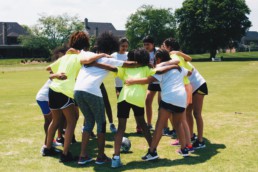Play Like a Girl On the Green
Tournament host Play Like a Girl and an elevated field of women and men of all skill levels compete at The Grove while having tons of fun raising funds to level the playing field for girls in STEM and sports. This elevated experience culminates with a one-of-a-kind Women in the Round songwriters concert.
When: June 14th, 2021
Where: Greg Norman Signature Golf Course at The Grove
Secure your spot at HERE
Scientific Benefits of Staying Active
Play Like a Girl aims to keep girls active and involved in sports--especially through middle school when they're most likely to quit. Research demonstrates that being part of a team helps girls develop self confidence, communication skills, motivation, leadership skills, and countless other benefits. Beyond that, staying active does a plethora of good for your physical health.
Let’s explore the science behind the positive outcomes of exercise:
Cardio
When you engage in cardiovascular activity, your heart rate, blood pressure, and breathing increase. Your heart works to pump blood, which carries oxygen, throughout your body. This provides your muscles with the necessary energy to move. Doing this for an extended period of time strengthens your heart and lungs. They become more efficient, meaning they can circulate more oxygenated blood through the body using fewer breaths and pumps. Regular cardiovascular exercise results in lower blood pressure and a more healthy heart and lungs. Examples of cardiovascular exercises include running, swimming, rowing and biking -- really, any sport or activity that elevates your heart and leaves you out of breath.
Strength
When you engage in strength training, your muscles contract and strip layers of cells off as a result of the physical exertion. During recovery, your body rebuilds the layers stripped during exertion and makes them stronger than before. Regular strength training maintains muscle mass, improves bone health, and controls body fat levels (higher amounts of muscle mass improve metabolism of fat). Also, when you maintain your muscle mass, you can prevent many kinds of injuries, as muscle is protective. Strength exercises include sit ups, push ups, pull ups, and often involve dumbbells or other kinds of weights. These types of exercises cause your muscles to feel tired the next day, which means they are rebuilding!
Flexibility
When you engage in flexibility training, your muscles are stretched out and blood rushes in. The blood carries oxygen and nutrients to them. Maintaining flexibility helps muscles maintain their length and strength. It is best to stretch both before and after being physically active. Stretching before exercise ensures that muscles are warmed up and oxygenated enough to reach a full range of motion. Stretching after exercise reduces tension in the muscles and ensures that they receive the nutrients to properly recover. Flexibility training includes activities like touching your toes, shoulder rolls, and any other stretches.
When you do any type of physical activity, your body releases endorphins. Endorphins are chemicals that react in a positive manner with the pain receptors in your brain. The release of endorphins boosts your mood and helps your body become more resilient. These useful chemicals also help your immune system function better.
Beyond that, exercise helps blood circulate to the brain better. The influx of blood flow to the brain stimulates it, helping you stay more awake and alert. It also aids the brain in forming new neural connections which retains plasticity, or the ability for the brain to rewire itself. Because of that, physical activity is linked to gains in academic performance.
STEM is everywhere and in every thing -- including our bodies. Be sure to consider the science behind what is happening inside your body the next time you exercise or play your favorite sport.
5 Ways to Keep Your Girls Active
Physical activity has multiple, far reaching effects that last into adulthood. For example, the physical training in a typical soccer practice helps reduce a girl's risk for depression while the strength training in that same practice will increase long-term skeletal health.
A commitment to physical activity is an investment in the future. Active girls do better academically, behaviorally and holistically.
Despite these and other known benefits, girls today may be the first generation to have a shorter life expectancy than their mothers due to a lack of sport participation and physical activity.
But we can change that.
Here are a few tips on how to keep your girls active:
- Host your own play day for your girls and their friends. Playing together with other girls in their own backyard not only gets your girls active, it also helps them navigate relationships and make memories that will last a lifetime.
- Sign your girls up for a local Play Like a Girl sports club or athletic team every season of the year. Play basketball in the winter--and softball in the spring. Take swimming in the summer. And run track in the fall. These are all great ways for girls to sample a variety of sports while being active year-round.
- Be your girls' role model with a weekly sweat session of your own. If you're not an athlete who's mastered a particular sport, you can always take a fitness class or simply schedule time for a brisk walk or run in your neighborhood.
- Watch a television series like HBO's Being Serena together to introduce your girls to strong, active women of all ages and backgrounds. Change their perspectives about remaining active as they age.
- Start early. The first 10 years of life are game-changing. These early years provide a critical window for creating a lifelong commitment to physical activity.

